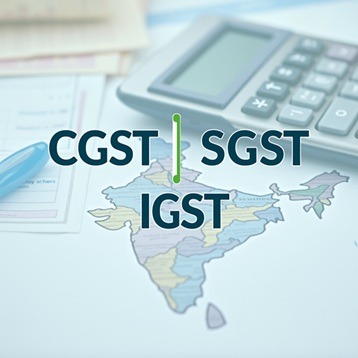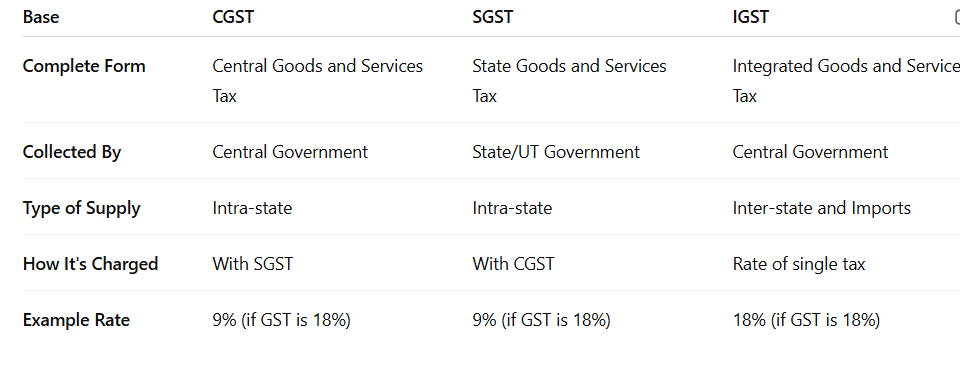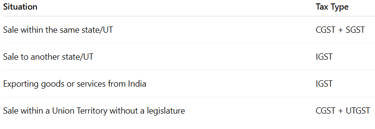CGST, SGST & IGST Differences Explained: Simple Guide to When Each Tax Applies
Learn the meaning, differences, and applicability of CGST, SGST, and IGST in India.
TAX & REGULATION
Ayushi
8/14/2025


When Goods and Services Tax (GST) came to India in 2017, it substituted many indirect taxes like VAT, service tax, excise duty, etc. GST isn't one tax — it is segmented into various components based on whether the transaction is occurring or not. Those segments are CGST, SGST, and IGST.
In this article, we will discuss what each of them is, how they vary, and when to use each of the taxes.
What Is GST?
Goods and Services Tax (GST) is a tax on the supply of goods and services in India. It is to be a single tax for the whole country; however, it is broken into pieces for distribution among and between the state and central governments.
In order to comprehend CGST, SGST, and IGST, one must remember that GST may be levied on two kinds of transactions:
Intra-state supply – supply of goods or services in a state or union territory.
Inter-state supply – supply of products or services from one state/UT to another.
What Is CGST?
CGST stands for Central Goods and Services Tax.
Collected by the Central Government.
Charged in the event of supply of goods or services within the same union territory or the same state (intra-state supply).
It is one half of the total GST levied on the transaction. The remaining half is SGST.
Example:
If a Delhi store sells furniture to a consumer in the same city for ₹50,000, the GST rate may be 18%:
CGST = 9% (₹4,500) — charged by the central government.
SGST = 9% (₹4,500) — levied by the Delhi government.
What Is SGST?
SGST refers to the State Goods and Services Tax.
Collected by the State Government (or Union Territory Government for UTs without a legislature).
Similar to CGST, it covers intra-state supply.
Both CGST and SGST are levied together in one bill for an intra-state transaction.
Example:
Following the last example of the Delhi store:
CGST = ₹4,500 is received by the central government.
SGST = ₹4,500 is collected by the Delhi government.
What Is IGST?
IGST stands for Integrated Goods and Services Tax.
Collected by the Central Government.
Charged on inter-state supply — when a product or a service is sold from one state to another or from a state/UT to another state/UT.
Also levied on imports of goods and services to India.
Example:
When a Delhi shop sells a ₹1,00,000 machine to a Maharashtra customer, and the GST is 18%, IGST of 18% (₹18,000) is charged. This is received by the central government and passed on to the destination state.
Important Differences Among CGST, SGST, and IGST
When Do CGST and SGST Apply?
CGST and SGST are applicable when:
Both the buyer and the supplier are in the same union territory or state.
The location of supply and location of supplier are both in the same state.
Example:
A tailor in Gujarat sews a suit and sells it to a customer in Gujarat. GST will be divided into:
CGST for the central government
SGST for the Gujarat state government
When Is IGST Used?
IGST applies when:
The buyer and the supplier are in two different Union Territories or states.
The supply point is in another state than the supplier.
Goods or services are brought into India.
Example:
A software firm based in Karnataka provides services to a purchaser in Tamil Nadu. IGST will be charged, and it will be remitted to the central government.
Why Is GST Fragmented into CGST, SGST, and IGST?
GST is divided to ensure that both state and central governments receive their share of tax revenue.
For intra-state transactions, the tax is shared equally (SGST + CGST).
For inter-state transactions, the central government levies IGST and distributes the share to the states involved.
Calculation of GST
Case 1: Intra-State Sale
Product price: ₹10,000
GST rate: 18% (9% CGST + 9% SGST)
CGST = ₹900
SGST = ₹900
Total Price = ₹10,000 + ₹900 + ₹900 = ₹11,800
Case 2: Inter-State Sale
Product price: ₹10,000
GST rate: 18% IGST
IGST = ₹1,800
Total Price = ₹10,000 + ₹1,800 = ₹11,800
Special Cases
Union Territories without Legislature – Instead of SGST, UTGST (Union Territory GST) is levied along with CGST.
Exports – Normally zero-rated under GST, but input tax credit is allowed.
Imports – IGST is charged on imports, along with customs duty.
Frequently Asked Questions on CGST, SGST, and IGST
1. Do I need to pay CGST and SGST separately?
No. The GST amount is divided automatically in the invoice. The seller collects it and pays the government.
2. Who determines the GST rates?
The GST Council, consisting of central and state government representatives, decides the rates.
3. Can businesses claim input tax credit on IGST?
Yes. Businesses can claim ITC on IGST paid, which can be set off against IGST, CGST, or SGST liability.
4. Why is IGST not split like CGST and SGST?
Because IGST is levied on inter-state supplies, it is collected centrally and later distributed to states.
Summary Table: Applicability of Each Tax
Conclusion
It is important for both businesses and consumers in India to understand CGST, SGST, and IGST. In short:
CGST + SGST is levied on intra-state sales.
IGST is charged on inter-state sales and imports.
This division ensures fair distribution of tax revenue between state and central governments and simplifies tax collection under the GST framework.




About Company


